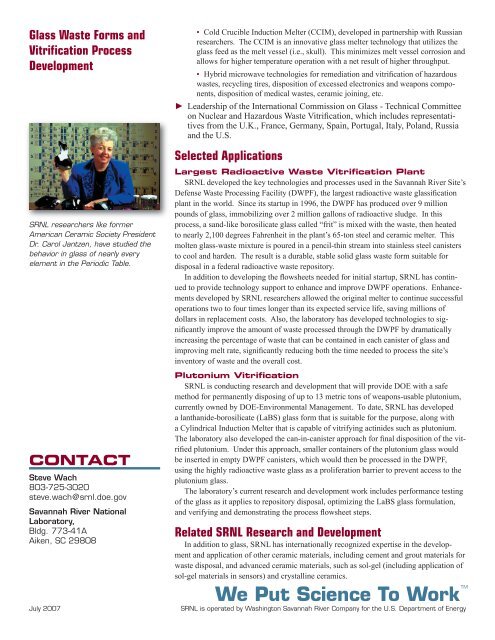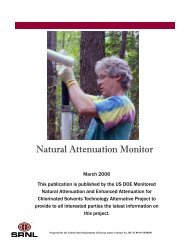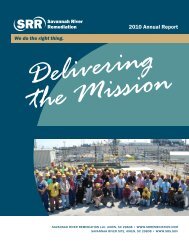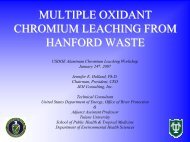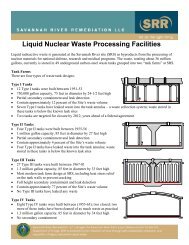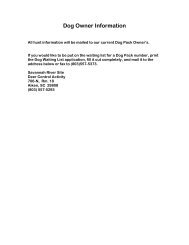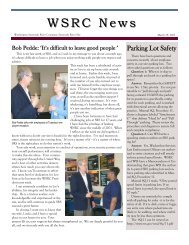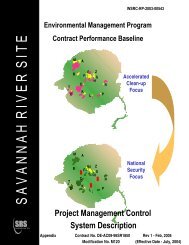Glass Waste Forms and Vitrification Process - Savannah River Site
Glass Waste Forms and Vitrification Process - Savannah River Site
Glass Waste Forms and Vitrification Process - Savannah River Site
You also want an ePaper? Increase the reach of your titles
YUMPU automatically turns print PDFs into web optimized ePapers that Google loves.
<strong>Glass</strong> <strong>Waste</strong> <strong>Forms</strong> <strong>and</strong><br />
<strong>Vitrification</strong> <strong>Process</strong><br />
Development<br />
SRNL researchers like former<br />
American Ceramic Society President<br />
Dr. Carol Jantzen, have studied the<br />
behavior in glass of nearly every<br />
element in the Periodic Table.<br />
CONTACT<br />
Steve Wach<br />
803-725-3020<br />
steve.wach@srnl.doe.gov<br />
<strong>Savannah</strong> <strong>River</strong> National<br />
Laboratory,<br />
Bldg. 773-41A<br />
Aiken, SC 29808<br />
• Cold Crucible Induction Melter (CCIM), developed in partnership with Russian<br />
researchers. The CCIM is an innovative glass melter technology that utilizes the<br />
glass feed as the melt vessel (i.e., skull). This minimizes melt vessel corrosion <strong>and</strong><br />
allows for higher temperature operation with a net result of higher throughput.<br />
• Hybrid microwave technologies for remediation <strong>and</strong> vitrification of hazardous<br />
wastes, recycling tires, disposition of excessed electronics <strong>and</strong> weapons components,<br />
disposition of medical wastes, ceramic joining, etc.<br />
► Leadership of the International Commission on <strong>Glass</strong> - Technical Committee<br />
on Nuclear <strong>and</strong> Hazardous <strong>Waste</strong> <strong>Vitrification</strong>, which includes representatitives<br />
from the U.K., France, Germany, Spain, Portugal, Italy, Pol<strong>and</strong>, Russia<br />
<strong>and</strong> the U.S.<br />
Selected Applications<br />
Largest Radioactive <strong>Waste</strong> <strong>Vitrification</strong> Plant<br />
SRNL developed the key technologies <strong>and</strong> processes used in the <strong>Savannah</strong> <strong>River</strong> <strong>Site</strong>’s<br />
Defense <strong>Waste</strong> <strong>Process</strong>ing Facility (DWPF), the largest radioactive waste glassification<br />
plant in the world. Since its startup in 1996, the DWPF has produced over 9 million<br />
pounds of glass, immobilizing over 2 million gallons of radioactive sludge. In this<br />
process, a s<strong>and</strong>-like borosilicate glass called “frit” is mixed with the waste, then heated<br />
to nearly 2,100 degrees Fahrenheit in the plant’s 65-ton steel <strong>and</strong> ceramic melter. This<br />
molten glass-waste mixture is poured in a pencil-thin stream into stainless steel canisters<br />
to cool <strong>and</strong> harden. The result is a durable, stable solid glass waste form suitable for<br />
disposal in a federal radioactive waste repository.<br />
In addition to developing the flowsheets needed for initial startup, SRNL has continued<br />
to provide technology support to enhance <strong>and</strong> improve DWPF operations. Enhancements<br />
developed by SRNL researchers allowed the original melter to continue successful<br />
operations two to four times longer than its expected service life, saving millions of<br />
dollars in replacement costs. Also, the laboratory has developed technologies to significantly<br />
improve the amount of waste processed through the DWPF by dramatically<br />
increasing the percentage of waste that can be contained in each canister of glass <strong>and</strong><br />
improving melt rate, significantly reducing both the time needed to process the site’s<br />
inventory of waste <strong>and</strong> the overall cost.<br />
Plutonium <strong>Vitrification</strong><br />
SRNL is conducting research <strong>and</strong> development that will provide DOE with a safe<br />
method for permanently disposing of up to 13 metric tons of weapons-usable plutonium,<br />
currently owned by DOE-Environmental Management. To date, SRNL has developed<br />
a lanthanide-borosilicate (LaBS) glass form that is suitable for the purpose, along with<br />
a Cylindrical Induction Melter that is capable of vitrifying actinides such as plutonium.<br />
The laboratory also developed the can-in-canister approach for final disposition of the vitrified<br />
plutonium. Under this approach, smaller containers of the plutonium glass would<br />
be inserted in empty DWPF canisters, which would then be processed in the DWPF,<br />
using the highly radioactive waste glass as a proliferation barrier to prevent access to the<br />
plutonium glass.<br />
The laboratory’s current research <strong>and</strong> development work includes performance testing<br />
of the glass as it applies to repository disposal, optimizing the LaBS glass formulation,<br />
<strong>and</strong> verifying <strong>and</strong> demonstrating the process flowsheet steps.<br />
Related SRNL Research <strong>and</strong> Development<br />
In addition to glass, SRNL has internationally recognized expertise in the development<br />
<strong>and</strong> application of other ceramic materials, including cement <strong>and</strong> grout materials for<br />
waste disposal, <strong>and</strong> advanced ceramic materials, such as sol-gel (including application of<br />
sol-gel materials in sensors) <strong>and</strong> crystalline ceramics.<br />
July 2007<br />
SRNL is operated by Washington <strong>Savannah</strong> <strong>River</strong> Company for the U.S. Department of Energy


